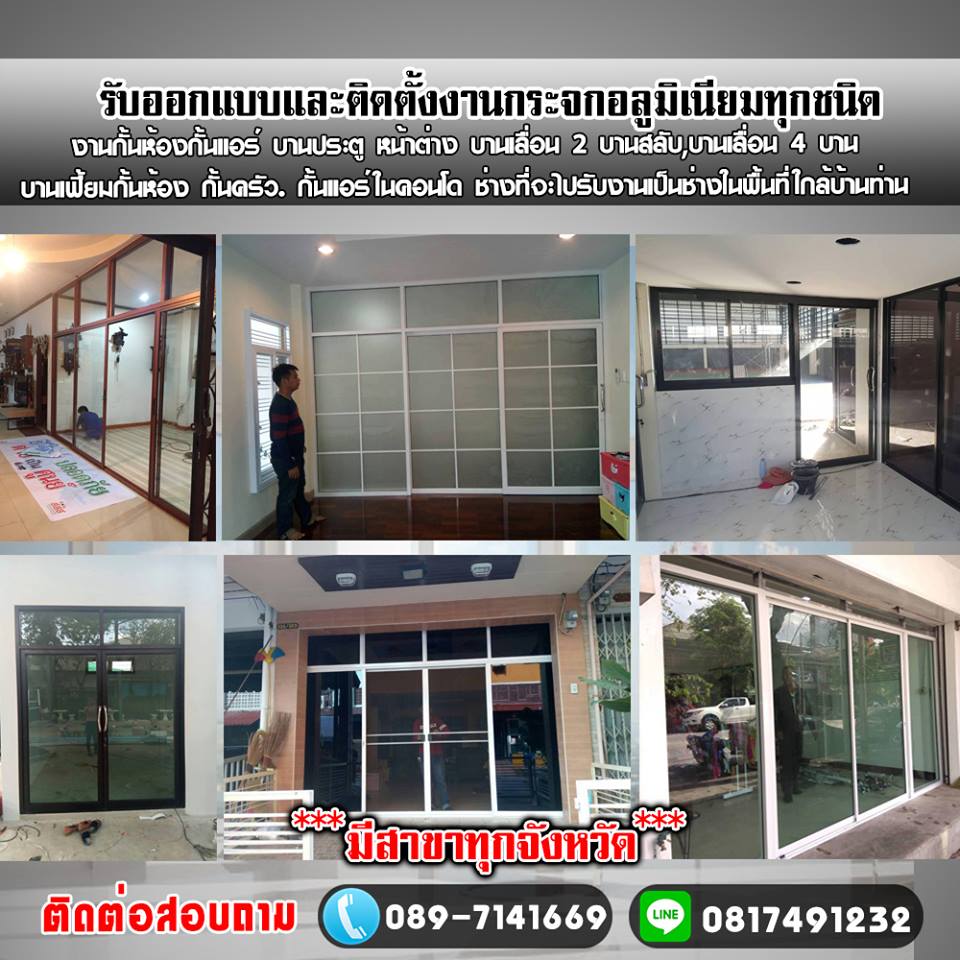ความหมายของกระจก
ความหมายของกระจก
ความหมายของกระจก
กระจก (glass) เป็นวัสดุที่ใช้ตกแต่งภายในอาคารเพื่อความสวยงามและเพิ่มความสว่างไสวให้กับอาคารบ้านเรือนใช้กับ อุตสาหกรรม ยานยนต์และมีการใช้งานทั่ว ๆ ไปอย่างกว้างขวางวัตถุดิบที่ใช้ในการผลิตกระจกประมาณ 80% ได้มาจากแหล่งผลิต ในประเทศได้แก่ ทรายแก้ว (silica sand) หินฟันม้า หินโดโลไมต์ (dolomite) เศษกระจก(cullets)และวัตถุดิบที่นำเข้าจาก ต่างประเทศ ได้แก่โซดาแอช ผงคาร์บอน ผงเหล็ก โซเดียมซัลเฟต
กรรมวิธีการผลิตกระจกจะเริ่มผลิตโดยการนำวัตถุดิบซึ่งได้แก่ ทรายแก้ว หินฟันม้า หินโดโลไมต์ เศษกระจก โซดาแอช หินปูน และโซเดียมซัลเฟตุมาผสมเข้าด้วยกันตามอัตราส่วนที่ได้กำหนดไว้ แล้วนำส่วนผสมที่ได้นั้นไปใส่ในเตา ที่มีอุณหภูมิ 1,500 องศาเซลเซียส จนวัสดุต่าง ๆ เกิดการหลอมละลายจนได้น้ำแก้ว (เชื้อเพลิงได้แก่ น้ำมันเตาซึ่งใช้แทนถ่านหิน) หลังจากนั้น จะปรับอุณหภูมิของน้ำแก้วให้เหลือประมาณ 1,100 องศาเซลเซียสจนมีความหนืดพอเหมาะต่อการขึ้นรูปน้ำแก้ว จะถูกนำไป ผ่านกระบวนการที่ทำให้เป็นแผ่นโดยวิธีการปล่อยให้ไหลลงไปฟอร์มตัวเป็นแผ่นกระจกบนผิวดีบอกแหลมกรรมวิธีนี้ จะได้ แผ่นกระจก ที่เรียกว่า กระจกโฟลต มีคุณสมบัติดีกว่าแผ่นกระจกที่ผลิตโดยระบบอื่น ๆ คือผิวของแผ่นกระจก จะเรียบ ไม่เป็นคลื่น มีความหนาสม่ำเสมอตลอดทั้งแผ่น ผิวสุกใส แวววาว ไม่ขุ่นมัว การผลิตกระจกแผ่นสามารถแบ่งออกได้เป็น 2 ขั้นตอน คือ
1. อุตสาหกรรมกระจกแผ่น
2. อุตสาหกรรมกระจกต่อเนื่อง
อุตสาหกรรมกระจกแผ่นเป็นอุตสาหกรรมการผลิตกระจกพื้นฐาน สามารถแบ่งออกเป็น 2 ชนิดใหญ่ ๆ ได้แก่
1. กระจกโฟลต (float glass)
2. กระจกชีต (sheet glass)
อุตสาหกรรมกระตกต่อเนื่อง
อุตสาหกรรมกระจกต่อเนื่องเป็นการนำกระจกโฟลตและกระจกชีตมาแปรรูป เพื่อประโยชน์ใช้สอยตามคุณสมบัติและลักษณะงานที่แตกต่างกันได้แก่
1. กระจกเงา (mirror glass)
2. กระจกสะท้อนแสง (heat reflection glass)
3. กระจกนิรภัยเทมเปอร์ (architectural flat tempered safety glass)
4. กระจกนิรภัยหลายชั้น (architectural flat laminaty safeted glass)
5. กระจกฉนวน (sealed insulating glass)
6. กระจกเสริมลวด (wired glass)
7. กระจกกันกระสุน เป็นกระจกที่ผลิตโดยการนำกระจกนิรภัยชนิดพิเศษมาติดกับกระจกนิรภัยหลายชั้น
The meaning of the mirror
Glass (glass) is a material used to decorate the interior of the building for beauty and to add brightness to the house, used in the automotive industry and has a wide range of uses. About 80% of the raw materials used in the manufacture of glass are derived from source of production Domestic such as silica sand, quarry stone, dolomite, cutlets and raw materials imported from abroad such as soda ash, carbon powder, iron powder, sodium sulfate.
The glass manufacturing process will begin by mixing the raw materials such as glass sand, quarry stone, dolomite stone, shards of glass, soda ash, limestone and sodium sulfate in the specified ratio. Then put the resulting mixture into the oven. With a temperature of 1,500 degrees Celsius until various materials are melted until the glass water is obtained fuels include After that, the temperature of the glass water is adjusted to about 1,100 degrees Celsius until it becomes viscous enough for the glass water to be formed. It is a glass sheet on a fine surface, telling the sharpness of this process to get a sheet of glass called float glass. It has better properties than glass sheets produced by other systems. The surface of the glass sheet is smooth, not wavy, has a uniform thickness throughout. Sheet with bright, shiny surface, not cloudy. The production of sheet glass can be divided into 2 steps:
1. Sheet glass industry
2. Continuous glass industry
The sheet glass industry is the basic glass manufacturing industry. Can be divided into two main types:
1. float glass
2. Sheet glass
The industry continues to fall
The continuous glass industry is the processing of float glass and sheet glass. For the benefit of use according to the different properties and types of work, including
1. mirror (mirror glass)
2. Heat reflection glass
3. Tempered glass (architectural flat tempered safety glass)
4. Multi-layer tempered glass (architectural flat laminate safe glass)
5. Sealed insulating glass
6. Wired glass
7. Bulletproof glass It is a glass that is produced by attaching a special type of safety glass to multiple layers of safety glass.
镜子的意义
玻璃(glass)是用于装饰建筑物内部以达到美观和增加房屋亮度的材料,用于汽车行业,用途广泛。玻璃制造所用的原材料约80%来源于产地国内如硅砂、采石、白云石、肉饼等以及从国外进口的纯碱、碳粉、铁粉、硫酸钠等原材料. .
玻璃制造过程首先将玻璃砂、采石、白云石、玻璃碎片、纯碱、石灰石和硫酸钠等原材料按指定比例混合。然后将所得混合物放入烤箱。在1,500摄氏度的温度下直到各种材料熔化直到获得玻璃水燃料包括之后,将玻璃水的温度调节到大约1,100摄氏度直到它变得足够粘以形成玻璃水。它是在精细表面上的玻璃板,讲述了获得称为浮法玻璃的玻璃板的过程的清晰度。它比其他系统生产的玻璃板具有更好的性能。玻璃板表面光滑,无波纹,整体厚度均匀。板材表面光亮、有光泽,不混浊。
1.平板玻璃行业
2、连续玻璃行业
平板玻璃产业是玻璃制造的基础产业。可以分为两种主要类型:
1. 浮法玻璃
2.平板玻璃
行业持续下滑
连续玻璃工业是浮法玻璃和平板玻璃的加工。根据不同的性质和类型的工作,为了使用的利益,包括
1.镜子(镜面玻璃)
2.热反射玻璃
3.钢化玻璃(建筑平面钢化安全玻璃)
4. 多层钢化玻璃(建筑平面夹层安全玻璃)
5. 密封中空玻璃
6. 夹丝玻璃
7、防弹玻璃是将特殊类型的安全玻璃贴附在多层安全玻璃上而制成的玻璃。


